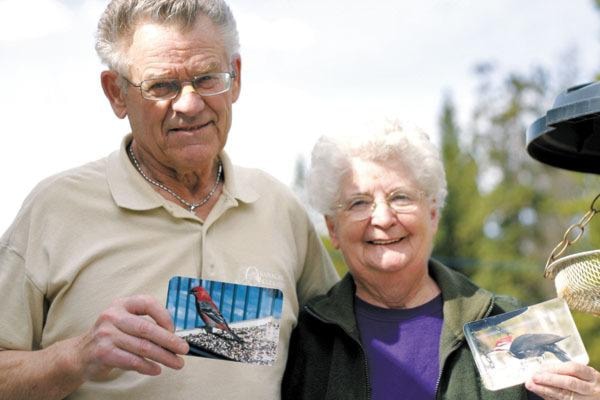"Beee beee bijur bijur!"
Sound familiar? If you're an American Dipper, that's your favourite song.
And if you're a birder like Evelyn Jaarsma or Dennis Verbeek, you know what tricks that little soot-grey bird is hiding: bright white eyelids that flash when it blinks and, tucked under those, a pair of see-through eye covers that work like swimming goggles when the Dipper dives into streams in search of scrumptious bugs.
Jaarsma is one of Houston's top birders, and she has seen the Dipper, a year-round northerner, diving at -30 C.
She's also seen birds that have no business being here: a so-called Common Eider, which is only common on Arctic and north Pacific coast; and a Hooded Oriole, whose Luckies-orange cap is more often spotted in Baja California palm trees.
"Officially, I guess I started in 1984," Jaarsma says, the year she started a bird journal.
Today, she has sighted 391 species—230 for the Bulkley Valley alone. And after nearly 30 years of keeping track, Jaarsma can tell you that Houston's robins usually show up between March 16 and 21, while hummingbirds arrive between April 19 and 27.
But Jaarsma enjoyed birding well before she started her journal.
She grew up in and later returned to a Barrett Station farm where she and her husband Bill have seen amazing birds, like the flock of Sandhill Cranes who performed their mating dance in the fields, jumping up and down to clack their beaks together.
At that time, she and Bill were keen to collect much slower-moving things: fossils, rocks and old glass bottles.
But when a fire suddenly burned down their house and melted their bottle collection, it also proved how much Jaarsma already liked to go birding.
"When our house burned, one lady gave us some money—she said it was for me to buy some make-up," said Jaarsma.
"But I bought binoculars instead," she says, smiling. "I missed that more than anything."

Recently, the Jaarsmas and several other Houston birders were back at the Barrett Station farm to see a stroke of birding luck—hummingbirds had built a nest and were raising their chicks just outside the farmhouse window.
Dennis Verbeek was among the lucky birders who got that call.
Verbeek says his birding started in 1995, when he landed a job banding warblers and other migratory birds near Edmonton for the Canadian Wildlife Service.
"They've had some of those birds come back as many as 11 seasons," he says.
Years later, Dennis and his wife Cindy got to do the same thing in Portugal, banding birds that were on a flight path to Africa.
Just five east African countries are home to more than 1300 bird species (all of North America has about 900).
When the Verbeeks made a trip to see people in Uganda two years ago, Dennis said his "life list" grew hardly without trying.
"Even when we were visiting, I think I picked up 180 species around the house," he said. A boat tour turned up more amazing sights, including some huge, carcass-eating storks ("Ugliest things ever," Cindy says), and purple-breasted Sunbirds that give off an iridescent glimmer when the light strikes them.
Now Kenya, along with Texas, is high on the Verbeeks' bucket list of places to go birding. But some of their interesting bird work has been here in Canada.
In 2002, they co-authored the first field guide to birds of the Mackenzie River delta that listed Gwich'in and Inuvialuit as well as English bird names.
It was a big help to bird scientists who flew to the area and wanted to ask local birders what they'd seen.
But their toughest assignment has surely been owl banding—their daughter Rebekah recently wowed her Grade 2 class with a shot of them holding a huge, surprisingly calm Grey Owl.
Once you grip an owl by its upper legs, Dennis says, it realizes it's hooped and tends to relax, even nuzzling its against your body.
But getting there is no easy task unless, like Dennis, you happen to be a long-time fisherman who's not afraid to work with mice.
To band owls, Dennis said it's best to drive along rural roads until you see one a half-mile or so away.
"You just pull the fishing rod out of the truck, have a fake mouse tied to the line, and cast it out as far as you can," he says. "As soon as the owl sees it, they glide off the tree and you start reeling it in."
Once the owl has flown in fairly close to get the fake mouse, it's time to throw it a live one.
"They get so focused on that mouse, they don't know what's going on," said Dennis.
In a final swoop, Dennis said he or Cindy would then catch the owl in a big hoop net before gingerly grasping it above the talons.
But new birders can have some amazing encounters without hardly trying, say the Verbeeks.
One cold spring day, they were surprised to find a yellow Townsend's Warbler standing motionless at the 7 Eleven. Dennis put the little bird on his shoulder, filled the tank, and then drove it home in a Kleenex box where it recovered and flew away.
Gas stations aside, both Evelyn and Dennis say Houston's Duck Pond is a good place to start birding, and not without its challenges—Evelyn and her sister-in-law once waded in without boots to get a peek at an often-heard but seldom seen Sora hiding among the reeds.
With a pair of wide-angle binoculars, both birders say early spring is a great time to go birding by the fields near Riverside Gardens, the "rabbit trail" road or the path that winds alongside Buck River.
And even if you don't know bird calls, Verbeek says you can have a lot of luck making a pssh pssh pssh sound.
"It sounds like young birds in the springtime, during nesting season," he explains. "Quite often that will bring birds right to you."
